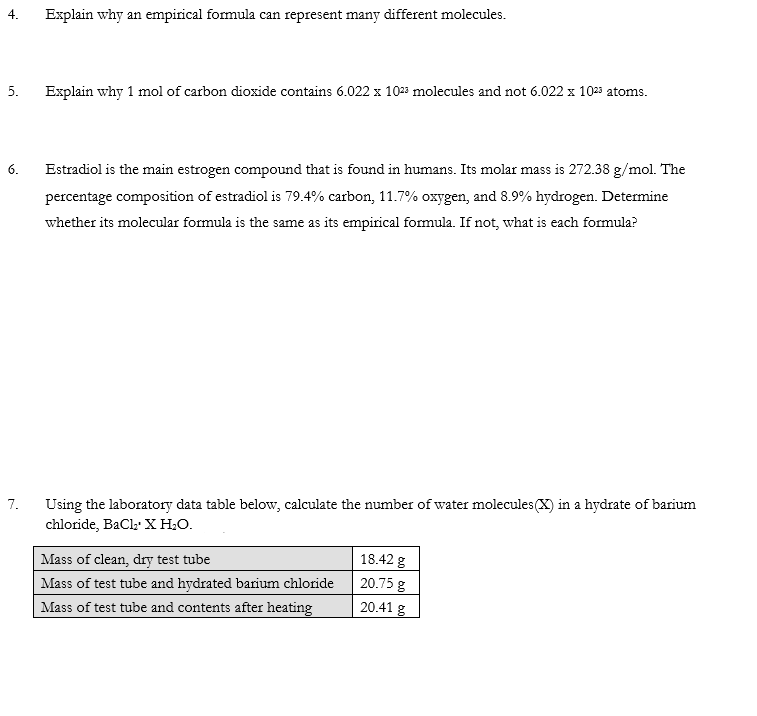4. Explain why an empirical formula can represent many different molecules. 5. Explain why 1 mol of carbon dioxide contains 6.022 x 1023 molecules and not 6.022 x 1023 atoms. Estradiol is the main estrogen compound that is found in humans. Its molar mass is 272 38 g/mol. The
4. Explain why an empirical formula can represent many different molecules. 5. Explain why 1 mol of carbon dioxide contains 6.022 x 1023 molecules and not 6.022 x 1023 atoms. Estradiol is the main estrogen compound that is found in humans. Its molar mass is 272 38 g/mol. The
Introductory Chemistry: A Foundation
9th Edition
ISBN:9781337399425
Author:Steven S. Zumdahl, Donald J. DeCoste
Publisher:Steven S. Zumdahl, Donald J. DeCoste
Chapter8: Chemical Composition
Section: Chapter Questions
Problem 96AP: A compound was analyzed and found to contain the following percentages of elements by mass: carbon,...
Related questions
Question

Transcribed Image Text:4.
Explain why an empirical formula can represent many different molecules.
5.
Explain why 1 mol of carbon dioxide contains 6.022 x 1023 molecules and not 6.022 x 10²³ atoms.
6.
Estradiol is the main estrogen compound that is found in humans. Its molar mass is 272.38 g/mol. The
percentage composition of estradiol is 79.4% carbon, 11.7% oxygen, and 8.9% hydrogen. Determine
whether its molecular formula is the same as its empirical formula. If not, what is each formula?
7.
Using the laboratory data table below, calculate the number of water molecules (X) in a hydrate of barium
chloride, BaCl₂ X H₂O.
Mass of clean, dry test tube
18.42 g
20.75 g
Mass of test tube and hydrated barium chloride
Mass of test tube and contents after heating
20.41 g
Expert Solution
This question has been solved!
Explore an expertly crafted, step-by-step solution for a thorough understanding of key concepts.
Step by step
Solved in 2 steps with 1 images

Knowledge Booster
Learn more about
Need a deep-dive on the concept behind this application? Look no further. Learn more about this topic, chemistry and related others by exploring similar questions and additional content below.Recommended textbooks for you

Introductory Chemistry: A Foundation
Chemistry
ISBN:
9781337399425
Author:
Steven S. Zumdahl, Donald J. DeCoste
Publisher:
Cengage Learning

Chemistry: Principles and Reactions
Chemistry
ISBN:
9781305079373
Author:
William L. Masterton, Cecile N. Hurley
Publisher:
Cengage Learning

Chemistry: An Atoms First Approach
Chemistry
ISBN:
9781305079243
Author:
Steven S. Zumdahl, Susan A. Zumdahl
Publisher:
Cengage Learning

Introductory Chemistry: A Foundation
Chemistry
ISBN:
9781337399425
Author:
Steven S. Zumdahl, Donald J. DeCoste
Publisher:
Cengage Learning

Chemistry: Principles and Reactions
Chemistry
ISBN:
9781305079373
Author:
William L. Masterton, Cecile N. Hurley
Publisher:
Cengage Learning

Chemistry: An Atoms First Approach
Chemistry
ISBN:
9781305079243
Author:
Steven S. Zumdahl, Susan A. Zumdahl
Publisher:
Cengage Learning


Chemistry
Chemistry
ISBN:
9781305957404
Author:
Steven S. Zumdahl, Susan A. Zumdahl, Donald J. DeCoste
Publisher:
Cengage Learning

Chemistry for Engineering Students
Chemistry
ISBN:
9781337398909
Author:
Lawrence S. Brown, Tom Holme
Publisher:
Cengage Learning